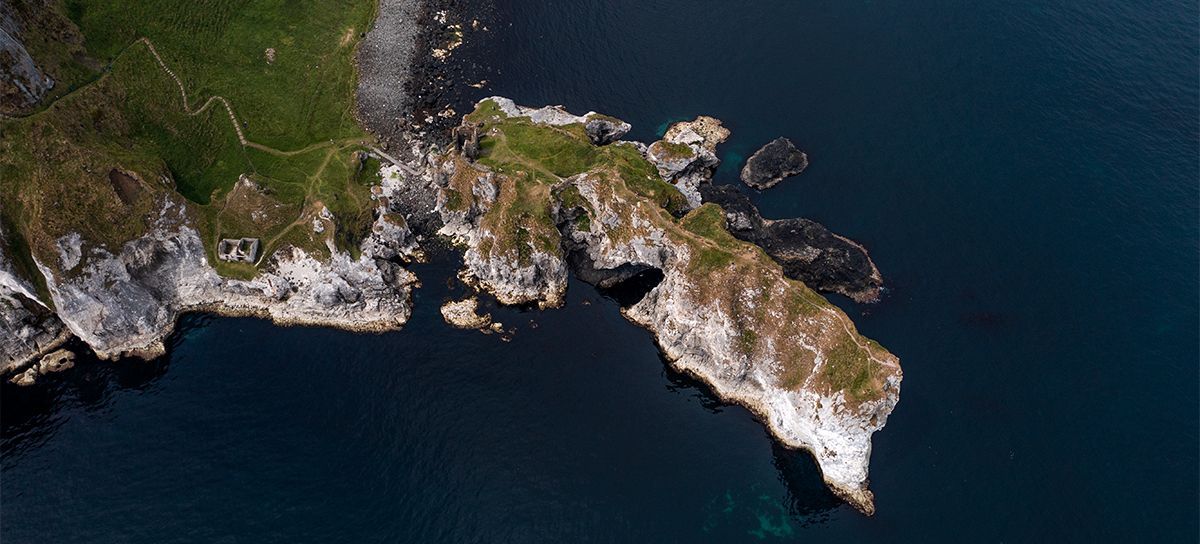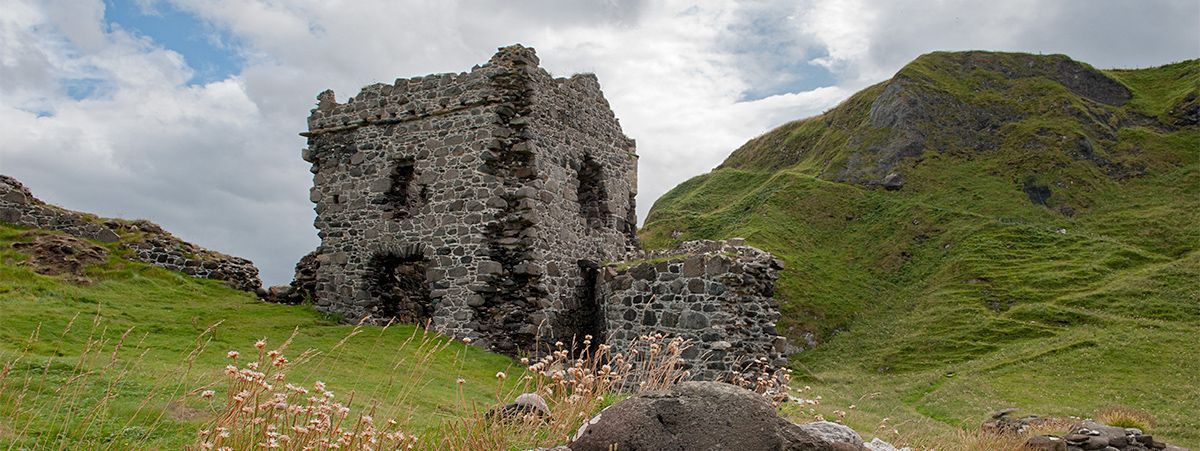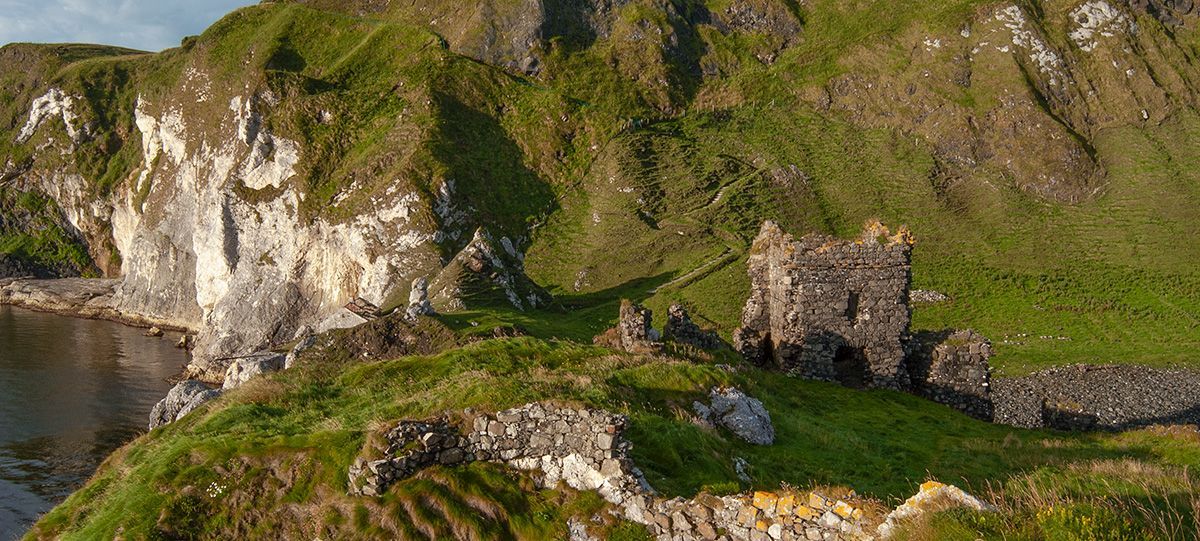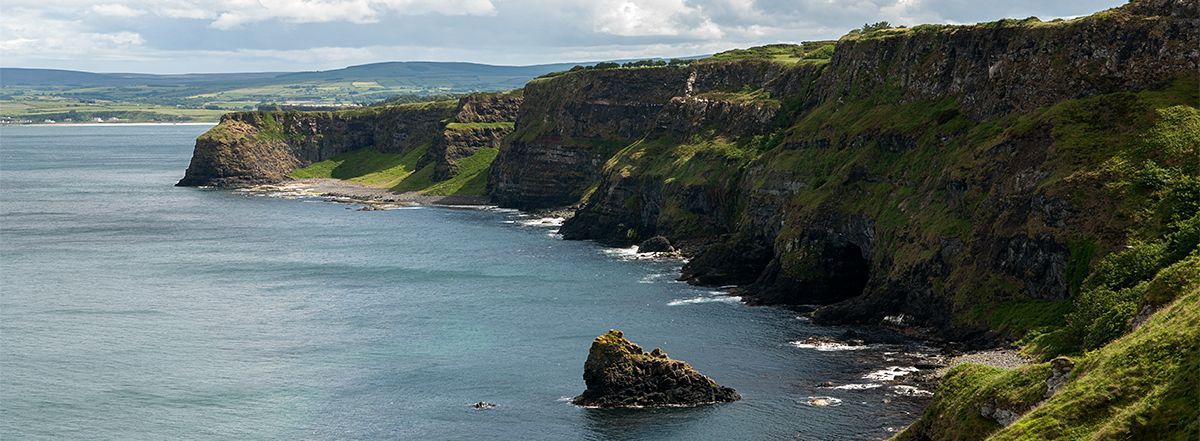Kinbane Castle
Kinbane, Kenbane, Kenbahn and others names are all variations of spelling for this beautiful location, a translate from the Gaelic 'Ceinn Bán' is White Head. The headland which is Cretaceous limestone is flanked on either side by volcanic basalt with several vents showing pyroclastic deposits. The headland reaches out into the Sea of Moyle and has commanding, strategic and panoramic views of the coast from Fair Head, Scotland and Raghery (Rathlin Island). Access is by foot down a series of steps which are quite a work out if you are getting long in the years. The road to the castle car park branches off the main Causeway Coastal Route and is signposted. Note: It is 100% not suitable for coaches of any description nor large RVs. The road is narrow, windy and ends in a small car park, care should be taken driving down it. Ultimately, the local authorities should be creating parking close to the main road to cater for the increased footfall, leaving the road free for local residents and those with disabilities, a shuttle bus service during the summer period with a small charge would solve the situation.

The ruins we see today consist of the castle and the remains of the salmon fishing bothy. The castle was built during the MacDonnell period of control along the north coast and played an intricate role in the power struggle and confrontations that occurred during the 1500s which involved Irish, Anglo-Irish, Scots and English forces. The castle was originally built by Colla MacDonnell, an elder brother of Sorley Boy MacDonnell. Colla had taken over the reins of the MacDonnell clan after their father Alexander died in 1538 at Stirling while visiting James V. The other brothers wanted nothing to do with leading the clan and returned to Scotland so next in line was Colla. He passed away in 1558 at Kinbane Castle, James then offered the title to his two offspring both of whom refused it due to the bloody nature of events that came with it, Sorely Boy then took over the reins of the MacDonnell clan.

Colla had married Evelyn MacQuillan, a marriage which brought a relative but short-lived calm in the conflict between the MacQuillans and MacDonnells clans. The MacQuillans land and property on the north coast came from de Mandevilles and had been in their possession since the 14th century, Dunluce Castle was their main stronghold and Evelyn was the future heiress of that, she would give birth to Archibald [Gillaspick] and Randall MacDonnell, Gillaspick was tragically killed after being gored by a bull at a games fair organized by Sorley Boy in Ballycastle (Dunaneeny Castle - home of Sorley Boy). This fair is frequently cited as being the foundation of the Lammas Fair tradition. Through the marriage of Colla and Evelyn the MacDonnells would eventually incorporate Dunluce Castle and its lands into their control under Sorley Boy MacDonnell.

Sorley Boy exchanged Kinbane Castle for a castle on the Isle of Colonsay where Colla Ciotach (son of Gillspick) went to live with his mother. Kinbane despite its idyllic and peaceful setting has witness many sieges and destruction over the centuries and the spilling of lots of blood including a massacre. The castle was finally given to Owen MacAllister by the MacDonnells for their loyalty and support in many of confrontations and battles that had ensued. The last person to inhabit Kinbane was a Mrs.MacAlister and that was in the late 18th century. The other ruin here is the bothy which along with several other locations formed a network of salmon fishing stations around the north coast. Salmon fishing probably started here when the castle was built and developed from there. In the car park you will see the remains of an ice house (building nearest the entrance path). This is where ice gathered in shallow dams during the winter would have been stored and then used to pack the fresh salmon into barrels for transportation to the markets.

The massacre I referred to previously took place circa 1550s when a contingent of English soldiers was sent from Carrickfergus by the Lord Deputy of Ireland to sort out the MacDonnells. After failing to get those inside to parley and submit to their orders, they made a fatal and tragic strategic blunder by descending and surrounding the castle from below. The clan inside the castle lit a fire on the headland which was a distress signal seen from Raghery and Ballycastle, this brought a large force of fighting men loyal to the MacDonnells who gathered on the cliffs above effectively trapping the English soldiers below who were all eventually killed in the hollow. From that point on the hollow became known as 'Lag na Sassenach' (Hollow of the English). The headland has a cave eroded through it which you cannot fully see from the shore but on a calm day can be accessed. I used walk over the moss rodden from where I lived at Brigend, Cloughcorr and camp here during the summer, much too crowded to do that nowadays.

If you do venture here and walk out on the headland itself do so in the knowledge that it is a very dangerous place for the unaware and especially if you have children or pets with you. There are no safety fencing and the path out to the headland is dangerous, I know of two accounts of people slipping and falling to their death from it. If it is a windy day don't even think about going beyond the castle enclosure. Apart from that you can spend idyllic hours along the foreshore, discover the waterfall, identify the old lazy beds, see if you can spot the two limestone outcrops that look like old men. The local people who would row to a place nearby to collect Spar (a clear crystal) which they sold to visitors at the Causeway, called it Reuben's Castle, I have still not found out why but it is a nice name for it.
